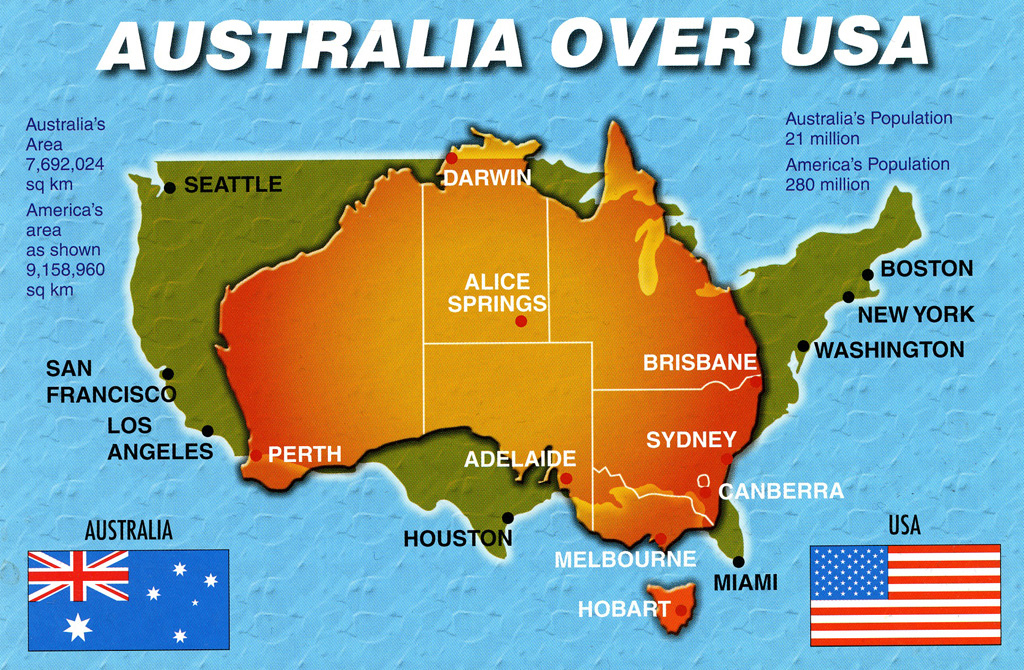When it comes to comparing the sizes of countries, Australia and the United States present an intriguing contrast. Both nations are known for their vast landscapes, but how do they stack up against each other in terms of total area, population density, and geographical features? As we delve into the details of Australia vs USA size, we will explore these aspects and more, helping you understand the significant differences and similarities between these two remarkable countries.
Australia, the sixth-largest country in the world, is often characterized by its unique ecosystems, sprawling deserts, and beautiful coastlines. Meanwhile, the USA, with its diverse geography ranging from mountains to plains and bustling cities, holds the title of the third-largest country by total area. The size comparison between Australia and the USA raises many questions about how geography influences culture, population distribution, and natural resources.
The exploration of Australia vs USA size also invites us to consider the implications of each country's size on its global standing, environmental policies, and economic opportunities. In this article, we will unfold a comprehensive comparison, answering essential questions that will provide deeper insights into these two diverse nations.
What is the Total Area of Australia vs USA?
The total area of a country is often a key factor in understanding its geographical dynamics. Australia's total land area is approximately 7.692 million square kilometers, making it the sixth-largest country in the world. In contrast, the United States covers about 9.834 million square kilometers, placing it third on the global scale. This stark difference in size raises questions about how each country's area affects its landscape, climate, and resources.
How Does Population Density Compare?
Population density is another crucial aspect to consider when comparing Australia vs USA size. Despite its vast land area, Australia has a relatively low population density, with around 3.3 people per square kilometer. This is primarily due to its expansive deserts and uninhabitable regions. On the other hand, the United States has a population density of approximately 36 people per square kilometer, largely influenced by its urban centers and diverse ecosystems.
What Are the Major Geographical Features?
Australia is renowned for its unique geographical features, including the Outback, the Great Barrier Reef, and the Australian Alps. These natural wonders contribute to the country's diverse ecosystems and rich biodiversity. Conversely, the United States boasts a wide range of geographical features, from the Rocky Mountains and Great Plains to the Appalachian Mountains and vast coastlines. Each country's geographical characteristics play a significant role in shaping its environment and lifestyle.
How Do Climate Zones Differ Between Australia and the USA?
The climate is a vital aspect of any country's geographic identity. Australia is known for its arid and semi-arid climates, with significant variations across its regions. The northern part experiences a tropical climate, while the southern regions can have a temperate climate. In contrast, the United States has a more diverse range of climate zones, including tropical, arid, temperate, and polar climates. This diversity leads to varied agricultural practices and lifestyle choices.
What Are the Impacts of Size on Economic Opportunities?
The economic opportunities available in a country can be heavily influenced by its size and resources. Australia, with its vast land, has a strong focus on agriculture, mining, and tourism. The country's size allows for large-scale farming and access to natural resources. Meanwhile, the USA has a more diversified economy, with significant contributions from technology, finance, healthcare, and manufacturing. The larger population and urban centers in the USA provide a robust market for various industries.
How Do Transportation Networks Compare?
Transportation is crucial for connecting regions within a country, especially when considering size. In Australia, the vast distances between cities lead to a reliance on road and air travel for transportation. Major cities like Sydney, Melbourne, and Brisbane are well-connected, but the outback regions may have limited access. In contrast, the United States boasts an extensive transportation network, including highways, railroads, and airports that facilitate efficient movement across its larger population and land area.
What Can Be Learned from Australia vs USA Size Comparison?
Comparing the sizes of Australia and the USA provides valuable insights into how geography influences various aspects of life, such as population distribution, economic opportunities, climate, and transportation. Understanding these differences can also foster a greater appreciation for the unique characteristics each country offers. Whether it's the breathtaking landscapes of Australia or the bustling cities of the USA, both nations hold significant places in the world, shaped by their size and geography.
In conclusion, the Australia vs USA size comparison reveals more than just land area; it uncovers the intricate relationship between geography, culture, and lifestyle in two of the world's most fascinating countries. By exploring these elements, we gain a deeper understanding of how size impacts every facet of life, from economics to environmental policies.
You Might Also Like
Timeless Elegance: Stunning Updos For Older WomenSnoop Dogg's Culinary Journey: The Snoop Dogg Cookbook
La Guía Definitiva: Como Poner Música En Estado De WhatsApp
Reviving The Vibe: The Ultimate Guide To 2000s Party Outfits
Exploring The Health Benefits Of Poke: Is Poke Healthy?
Article Recommendations
- Jackerman Mothers Warmth Chapter 3
- Alaina_elliss Leaked
- Oliver Jordan Ressler
- Daisy Melamine Official
- Sophie Rain Spider Man
- Madelyn Cline Naked
- In The Heat Of The Night Cast
- Marty Raney Net Worth
- וילה פיצגרלד
- Bill Burrs Wife And Kids


